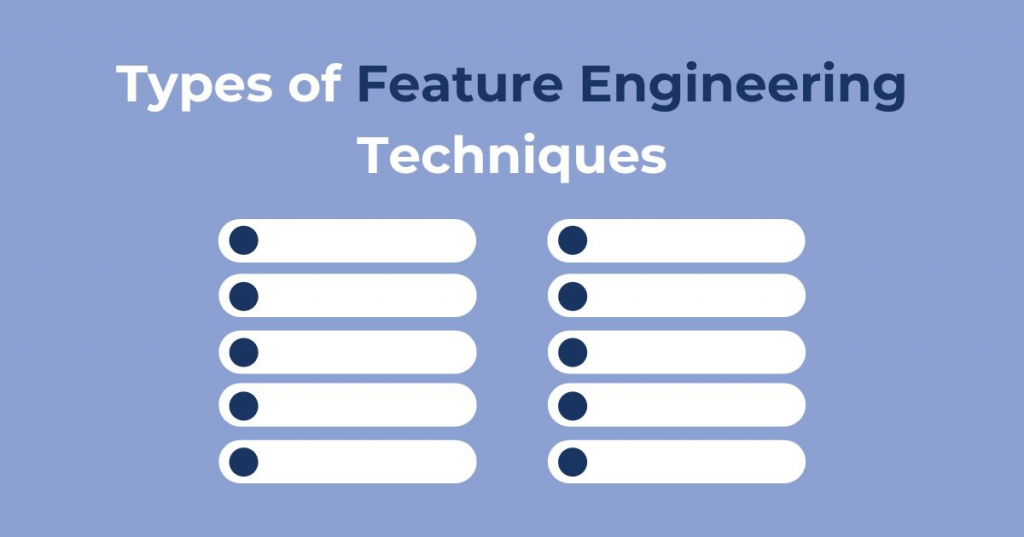Feature Engineering 101: What It Is & Why It Matters
Welcome to SkillTrans, your one-stop shop for acquiring and sharing in-demand skills! Today, we're diving into the world of machine learning (ML) and a fundamental concept that separates good models from exceptional ones: Feature Engineering.
What is Feature Engineering?
According to Wikipedia: “Feature engineering is a preprocessing step in supervised machine learning and statistical modeling which transforms raw data into a more effective set of inputs. Each input comprises several attributes, known as features. By providing models with relevant information, feature engineering significantly enhances their predictive accuracy and decision-making capability.”
For short, Feature engineering in machine learning refines raw data into meaningful features to improve model performance.
Why is Feature Engineering Important?

At SkillTrans, we understand the importance of practical learning. Feature engineering isn't just another theory – it's the secret sauce behind powerful ML applications across various fields.
Here's how it empowers different areas:
Feature Engineering in Machine Learning
Machine learning algorithms rely heavily on the quality and relevance of features they are trained on. Feature engineering in machine learning focuses on creating the best possible set of features from raw data to improve the performance of the model. This involves several techniques:
Feature selection: Choosing the most informative features from the available data. Irrelevant or redundant features can hinder the learning process.
Feature creation: Deriving new features from existing ones through calculations or domain knowledge. These new features can capture more complex relationships in the data.
Feature transformation: Scaling, normalizing, or encoding features to ensure they are on a similar scale and interpretable by the chosen machine learning algorithm.
Domain expertise plays a significant role in machine learning's feature engineering. Understanding the data and the problem being addressed allows data scientists to select and create the most effective features for the model. Additionally, engineered features are often more interpretable, which helps in understanding how the model arrives at its predictions.
Feature Engineering in Artificial Intelligence (AI)
While feature engineering is crucial in machine learning, AI is a broader field encompassing various techniques beyond machine learning models. Feature engineering might be used in conjunction with some AI techniques, but its role can vary depending on the specific application.
For example, in natural language processing (NLP), feature engineering might involve pre-processing text data like tokenization (breaking down text into words) or stemming (reducing words to their root form). However, AI techniques like deep learning can handle these tasks automatically.
Overall, the emphasis on feature engineering in AI is less pronounced compared to machine learning. Domain knowledge can still be valuable in specific AI applications but to a lesser extent.
Feature Engineering in Deep Learning
Deep learning algorithms, inspired by the structure of the human brain, can learn complex representations from raw data through a series of interconnected layers called artificial neural networks. This allows deep learning models to automatically extract features from the data itself. This reduces the need for manual feature engineering compared to traditional machine learning approaches.
However, deep learning models often learn features that are opaque and difficult to interpret. While this doesn't necessarily hinder their effectiveness, it can be challenging to understand the rationale behind their decisions.
Even though deep learning automates much of feature extraction, there can still be some role for traditional feature engineering techniques. Preprocessing data for deep learning models might involve cleaning, normalization, or dimensionality reduction.
Feature Engineering: Machine Learning vs. AI vs. Deep Learning
Here's a table outlining the key differences in feature engineering across Machine Learning, AI, and Deep Learning:
| Aspect | Machine Learning (ML) | Artificial Intelligence (AI) (Encompasses ML and DL) | Deep Learning (DL) (Subset of ML) |
| Feature Engineering | Crucial: Requires significant domain expertise and manual effort to select, transform, and create features. | Varies: This can be manual in some AI systems or automated in others (like DL). | Less Manual: Automatic feature extraction through layers of neural networks. Minimizes the need for manual input. |
| Examples | Selecting relevant columns from a dataset. | Designing rules or heuristics for a chess-playing AI. | Identifying edges in an image within a convolutional neural network (CNN). |
| Pros | Interpretable: Features often have clear meanings. | Flexibility: Can be applied to a wide range of problems. | Powerful: Can learn complex representations from raw data. |
| Cons | Time-consuming and labor-intensive. | Can be computationally expensive depending on the complexity of the algorithm. | Powerful: Can learn complex representations from raw data. |
| Use Cases | Predictive modeling (e.g., customer churn prediction) | Natural Language Processing (NLP), robotics, game playing | Image and speech recognition, natural language understanding |
Table: Feature Engineering in Machine Learning vs. AI vs. Deep Learning by SkillTrans
Keytake Notes:
Machine Learning (ML): Traditional ML algorithms heavily rely on the quality of features engineered by humans.
Artificial Intelligence (AI): A broad field that can involve both manual and automated feature engineering.
Deep Learning (DL): A subset of ML that excels at automatically learning features from raw data, especially in tasks like image or speech recognition.
Understanding Features

Before diving into the art of feature engineering, it's essential to grasp the fundamental concept of features themselves. In the realm of machine learning, features are the building blocks that fuel a model's ability to learn and make predictions. Imagine them as the individual ingredients in a recipe – each with its unique properties and contributing to the final outcome.
Just like a delicious dish relies on a well-chosen combination of ingredients, a powerful machine-learning model hinges on informative and relevant features. These features act as the measurable characteristics that define the data being analyzed. They serve as the language the model understands, allowing it to identify patterns, make connections, and ultimately, generate predictions.
Let's illustrate this concept with a practical example. Suppose you're building a machine learning model to predict house prices. In this scenario, features could encompass a variety of quantifiable aspects of a house, such as:
Square footage: This numerical value provides an indication of the house's size.
Number of bedrooms: This discrete feature highlights the number of sleeping quarters available.
Location: This could be represented in various ways, such as zip code, neighborhood, or even latitude and longitude. Each method captures the geographical context of the property.
By feeding the model with these features, it can learn the relationships between them and house prices. For instance, the model might discover that larger houses (higher square footage) and those with more bedrooms typically command higher prices.
Similarly, it could identify trends based on location, understanding that houses in certain neighborhoods or zip codes generally sell for more.
The quality and selection of features ultimately determine the effectiveness of the machine learning model. By providing the model with the most informative and relevant features, you empower it to make accurate and insightful predictions.
In essence, understanding features is the first step towards mastering the art of feature engineering – the process of crafting the perfect set of ingredients for your machine-learning recipe.
Types of Feature Engineering Techniques

Feature engineering is the art and science of transforming raw data into meaningful features that enhance machine learning model performance. It involves a wide array of techniques to address various data challenges and optimize model input.
Here are some common types of feature engineering techniques:
Imputation
Missing data is a common issue in real-world datasets. Imputation techniques fill these gaps, preventing errors and ensuring algorithm functionality.
Mean/Median/Mode Imputation: The simplest approach, filling missing values with the mean (average), median (middle value), or mode (most frequent value) of the existing data. This can be suitable for numerical features with relatively few missing values.
Regression Imputation: A more sophisticated method using a regression model to predict missing values based on other features. It can be effective when there are strong relationships between features.
K-Nearest Neighbors Imputation: This technique identifies the k-nearest data points (based on feature similarity) to the one with missing values and imputes the missing value based on the average of its neighbors.
Handling Outliers
Outliers are extreme data points that can skew model results. Dealing with them requires careful consideration.
Winsorization: Capping outliers at a certain percentile (e.g., replacing values above the 95th percentile with the 95th percentile value). This helps to retain some information about outliers while reducing their influence.
Transformation: Applying mathematical transformations like logarithmic or square root transformations can reduce the impact of outliers by compressing the data distribution.
Binning
Binning transforms continuous variables into categorical ones. This can be useful for certain algorithms and improve model interpretability.
Equal-Width Binning: Divides the range of values into a fixed number of equal-sized intervals or bins. This is straightforward but may not capture natural groupings in the data.
Equal-Frequency Binning (Quantile Binning): Divides the values into bins such that each bin contains approximately the same number of observations. This can reveal patterns hidden in the distribution.
Logarithmic Transformation
Skewed data (where values cluster towards one end of the distribution) can be problematic for some algorithms. Logarithmic transformations normalize these distributions and often make relationships more linear.
Natural Logarithm (ln): Applying the natural logarithm (ln) to a feature can reduce right skewness.
Other Logarithms (log10, log2): Variations using base 10 or base 2 can be explored depending on the data.
One-Hot Encoding
Many algorithms work best with numerical data. One-hot encoding transforms categorical variables into a set of binary (0 or 1) features, with each feature representing a specific category.
Example: A "color" variable with categories "red," "green," and "blue" would become three separate features: "is_red," "is_green," and "is_blue."
Grouping Operations
Grouping data and calculating statistics (e.g., mean, sum, count) can create informative new features.
Example: In a dataset of customer transactions, calculating the average purchase amount for each customer can be a valuable feature for predicting future spending.
Feature Splitting
Splitting a feature into multiple parts can reveal hidden information.
Example: Splitting a "date" feature into "year," "month," and "day" allows algorithms to separately analyze the impact of each time component.
Scaling
Features with significantly different scales can cause issues for some algorithms. Scaling techniques ensure all features have a similar range.
Standardization (Z-score Scaling): Transforms features to have a mean of 0 and a standard deviation of 1. This is widely used and appropriate for many scenarios.
Min-Max Scaling: Scales feature a specific range (typically 0 to 1). This can be useful when you want to preserve the original data distribution.
Extracting Date/Time Features
Date/time features contain valuable information. Extracting components like a day of the week, month, or time of day can reveal patterns related to seasonality or specific events.
Polynomial Features
Polynomial features (created by raising existing features to powers) can model complex non-linear relationships between features.
Feature Selection
Datasets often contain irrelevant or redundant features. Feature selection techniques identify the most important features, reducing dimensionality and potentially improving model performance.
Filter Methods: Use statistical tests (e.g., correlation, chi-square) to assess feature relevance.
Wrapper Methods: Iteratively evaluate feature subsets using a model's performance as a selection criterion.
Embedded Methods: Incorporate feature selection into the model training process itself (e.g., LASSO regression).
Feature Engineering Examples
Now that you understand the importance of features, let's explore some ways to manipulate them and create an even stronger foundation for your machine-learning models. Feature engineering is like sharpening your tools in the machine learning workshop – it equips you with techniques to refine the data your model uses, ultimately leading to better results.
Here are a few key examples to get you started:
Feature Creation
Imagine you have data on customer purchases, including individual transactions. A simple feature might be the total amount spent per purchase. But what if you want to understand a customer's overall buying habits? Feature creation allows you to craft new features based on existing ones.
For example, you could create a new feature called "total spent in the last year" by summing up the purchase amounts within a specific time frame. This gives your model a more comprehensive picture of a customer's spending behavior.
Feature Scaling
Data often comes in different formats and units. For instance, house prices might be in the millions, while square footage is just a number. This difference in scale can confuse a machine learning model, giving undue weight to features with larger numerical values.
Feature scaling techniques like normalization or standardization come to the rescue. These techniques adjust the values of each feature to a common range, ensuring all features contribute equally to the model's learning process.
Feature Selection
Not all features are equally important for your model. Some might be irrelevant to the problem you're trying to solve, while others might be redundant, providing the same information as another feature.
Feature selection helps you identify and remove these unnecessary features. Think of it as decluttering your data workbench – you keep the essential tools and discard the outdated ones. This not only improves the model's performance by focusing its learning on the most relevant information, but it can also reduce the time it takes to train the model.
These are just a few examples, and the feature engineering toolbox offers many more techniques. As you delve deeper into machine learning, you'll discover a wider range of methods to tailor your data and empower your models to make even more insightful predictions.
Become a Feature Engineering Pro at SkillTrans
Feature engineering is a vast and rewarding field. This blog post is just the beginning! Explore SkillTrans' extensive course library to discover numerous techniques and tools. With dedication and the right resources, you can refine your feature engineering skills and become a machine learning pro!
Ready to take your machine learning journey to the next level? Browse SkillTrans' courses on data science and artificial intelligence to find the perfect fit for your goals!

Meet Hoang Duyen, an experienced SEO Specialist with a proven track record in driving organic growth and boosting online visibility. She has honed her skills in keyword research, on-page optimization, and technical SEO. Her expertise lies in crafting data-driven strategies that not only improve search engine rankings but also deliver tangible results for businesses.



